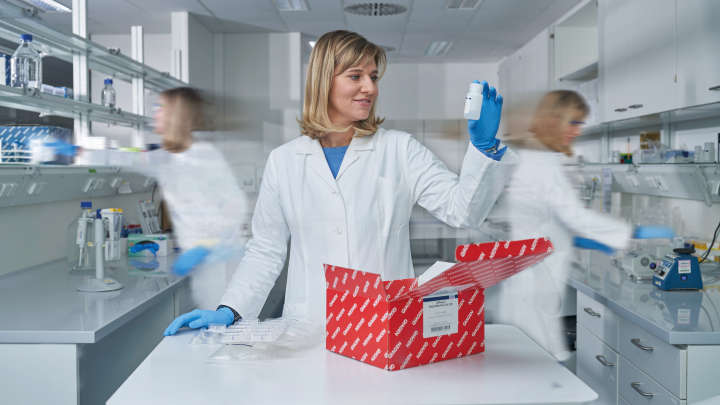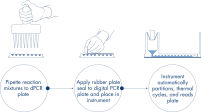✓ Procesamiento automático sin interrupción de pedidos en línea
✓ Servicio técnico y para productos experto y profesional
✓ Realización y repetición de pedidos rápidas y fiables
QIAcuity Probe PCR Kit (5 ml)
N.º de cat. / ID. 250102
✓ Procesamiento automático sin interrupción de pedidos en línea
✓ Servicio técnico y para productos experto y profesional
✓ Realización y repetición de pedidos rápidas y fiables
Características
- Para reacciones simples y hasta 5-plex
- Mezcla maestra concentrada 4x para cargar más muestra
- Optimizado para el uso de microfluidos en las QIAcuity Nanoplates
- Menos amplificación inespecífica por PCR
- Conforme a la norma REACH
Detalles del producto
El QIAcuity Probe PCR Kit contiene la mezcla maestra lista para usar concentrada 4x y optimizada para el uso de microfluidos en las QIAcuity Nanoplates. El kit mejora la especificidad y la eficiencia de la PCR digital basada en sonda para ofrecer análisis exactos simples o hasta 5-plex. La QIAcuity Probe Master Mix está optimizada para aumentar la especificidad para la cuantificación exacta de ADNg o ADNc en los instrumentos QIAcuity dPCR.
El kit funciona junto con el QIAcuity Digital PCR System y las QIAcuity Nanoplates.
¿Le gustaría obtener más información sobre el producto y que uno de nuestros especialistas en dPCR se ponga en contacto con usted? Regístrese aquí y nos pondremos en contacto con usted en breve.
Rendimiento
Rendimiento superior
Las QIAcuity Master Mixes para la dPCR basada en sondas de hidrólisis utilizan las versiones más recientes de ADN polimerasa de alta calidad de QIAGEN. La combinación única de la patentada tecnología de solución tampón de eficacia comprobada de QIAGEN optimizada para microfluidos de nanoplacas, junto con el nuevo QuantiNova DNA Polymerase permite obtener resultados uniformes en lo que respecta a sensibilidad, reproducibilidad y eficacia.
Detección basada en sondas simple a 5-plex con el QIAcuity Probe PCR Kit
La mezcla maestra especial en el QIAcuity Probe PCR Kit permite la cuantificación exacta de hasta 5 blancos con grandes diferencias en el nivel de abundancia en un pocillo de la QIAcuity Nanoplate. Esto le permite ahorrar tiempo, dinero y reduce la cantidad de material de muestra necesario. Además, los datos de PCR dobles y múltiples obtenidos son similares a los que se obtienen con una PCR simple.
Estabilidad en la reacción de hasta 100 horas
Las mezclas para PCR QIAcuity pueden almacenarse a una temperatura de 30 °C durante un máximo de 100 horas sin que se altere el rendimiento de las reacciones posteriores. La excelente estabilidad, incluso tras un almacenamiento prolongado a temperatura ambiente sin el uso de ningún agente refrigerante hace que el QIAcuity Probe PCR Kit sea ideal para la configuración de reacciones de alto rendimiento y la manipulación de pilas de placas.
Principio
El QIAcuity Probe PCR Kit proporciona análisis de ADNc o ADNg simple o múltiple con máxima especificidad gracias a su novedoso mecanismo de inicio en caliente mediado por anticuerpos. A bajas temperaturas, el QuantiNova DNA Polymerase se mantiene en un estado inactivo por acción del anticuerpo QuantiNova Antibody y un nuevo aditivo, QuantiNova Guard, que estabiliza el complejo. De esta manera, se mejora la rigurosidad del inicio en caliente y previene la extensión de cebadores y de dímeros de cebadores hibridados de manera no específica. A los 2 minutos de haber alcanzado una temperatura de 95 °C, el QuantiNova Antibody y el QuantiNova Guard se desnaturalizan y se activa la QuantiNova DNA Polymerase, lo que permite la amplificación por PCR.
El principio de la reacción de dPCR en las nanoplacas se describe aquí.
Procedimiento
Al igual que en los experimentos de qPCR, la preparación de las muestras incluye la transferencia de mezcla maestra, sondas y cebadores a una nanoplaca de 96 o 24 pocillos, seguida de la adición de las muestras. El sistema integra funciones de división, termociclado y obtención de imágenes en un solo instrumento completamente automatizado que permite a los usuarios obtener los resultados de las muestras en menos de 2 horas. Es posible realizar un análisis en el paquete de software, que proporciona la concentración en copias por microlitro de la secuencia de blancos y también para el control de calidad como muestras positivas o NTC. Este análisis también se puede extender a ordenadores remotos dentro de la misma red de área local (LAN).
Aplicaciones
El QIAcuity Probe PCR Kit, junto con el QIAcuity Digital PCR System y las QIAcuity Nanoplates, permiten el análisis cuantitativo de dianas de ADNc y ADNg para utilizarlas en aplicaciones, entre las que se incluyen:
- Detección de mutaciones poco frecuentes
- Análisis de variación en el número de copias
- Análisis de expresión génica
- Detección de microrganismos patógenos
- Genotipado
- Investigación sobre miARN
- Terapia celular y génica
- Cuantificación de ADN residual
- Control de aguas residuales
Datos y cifras de respaldo
Flujo de trabajo simple y rápido basado en la placa



